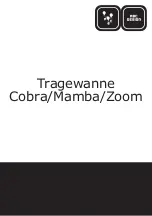
DMC-1500
Chapter 6 Programming Motion
•
51
The command, VP xy specifies the coordinates of the end points of the vector movement with respect
to the starting point. Non-sequential axes do not require comma delineation. The command, CR r,q,d
define a circular arc with a radius r, starting angle of q, and a traversed angle d. The notation for q is
that zero corresponds to the positive horizontal direction, and for both q and d, the counter-clockwise
(CCW) rotation is positive.
Up to 511 segments of CR or VP may be specified in a single sequence and must be ended with the
command VE. The motion can be initiated with a Begin Sequence (BGS) command. Once motion
starts, additional segments may be added.
The Clear Sequence (CS) command can be used to remove previous VP and CR commands which
were stored in the buffer prior to the start of the motion. To stop the motion, use the instructions STS
or AB1. ST stops motion at the specified deceleration. AB1 aborts the motion instantaneously.
The Vector End (VE) command must be used to specify the end of the coordinated motion. This
command requires the controller to decelerate to a stop following the last motion requirement. If a VE
command is not given, an Abort (AB1) must be used to abort the coordinated motion sequence.
It is the responsibility of the user to keep enough motion segments in the DMC-1500 sequence buffer
to ensure continuous motion. If the controller receives no additional motion segments and no VE
command, the controller will stop motion instantly at the last vector. There will be no controlled
deceleration. LM? or _LM returns the available spaces for motion segments that can be sent to the
buffer. 511 returned means the buffer is empty and 511 segments can be sent. A zero means the
buffer is full and no additional segments can be sent. As long as the buffer is not full, additional
segments can be sent at PC bus speeds.
The operand _CS can be used to determine the value of the segment counter.
Specifying Vector Acceleration, Deceleration and Speed:
The commands VS n, VA n, and VD n are used to specify the vector speed, acceleration and
deceleration. The DMC-1500 computes the vector speed based on the two axes specified in the VM
mode. For example, VM YZ designates vector mode for the Y and Z axes. The vector speed for this
example would be computed using the equation:
VS
2
=YS
2
+ZS
2
, where YS and ZS are the speed of the Y and Z axes.
In cases where the acceleration causes the system to 'jerk', the DMC-1500 provides a vector motion
smoothing function. VT is used to set the S-curve smoothing constant for coordinated moves.
Additional Commands
The DMC-1500 provides commands for additional control of vector motion and program control.
Note: Many of the commands used in Vector Mode motion also applies Linear Interpolation motion
described in the previous section.
Trippoints
The command AV n is the ‘After Vector’ trippoint, which halts program execution until the vector
distance of n has been reached.
Specifying Vector Speed for Each Segment
The vector speed may be specified by the immediate command VS. It can also be attached to a motion
segment with the instructions
VP x,y, < n
CR
r,
θ,δ
< n
Содержание DMC-1510
Страница 6: ......
Страница 18: ...6 Chapter 1 Overview DMC 1500 THIS PAGE LEFT BLANK INTENTIONALLY...
Страница 88: ...76 Chapter 6 Programming Motion DMC 1500 Figure 6 7 Motion intervals in the Home sequence...
Страница 90: ...78 Chapter 6 Programming Motion DMC 1500 THIS PAGE LEFT BLANK INTENTIONALLY...
Страница 137: ...DMC 1500 Chapter 7 Application Programming 125 THIS PAGE LEFT BLANK INTENTIONALLY...
Страница 157: ...DMC 1500 Chapter 10 Theory of Operation 145 THIS PAGE LEFT BLANK INTENTIONALLY...
Страница 160: ...148 Appendices DMC 1500 Card Level Layout...
Страница 178: ...166 Appendices DMC 1500 ICM 1100 Drawing 1 3 4 0 0 4 4 0 2 4 0 7 0 0 4 5 3 7 0 5 7 0 2 8 5 1 0 0 1 0 1 0 7 0 1 0 0...
Страница 180: ...168 Appendices DMC 1500...
Страница 198: ...186 Appendices DMC 1500 THIS PAGE LEFT BLANK INTENTIONALLY...
















































